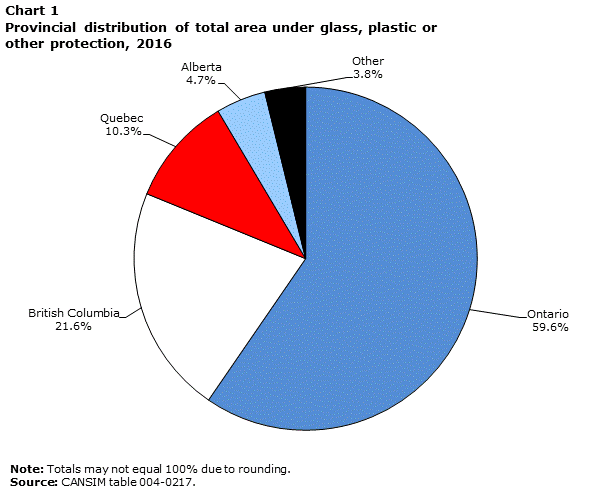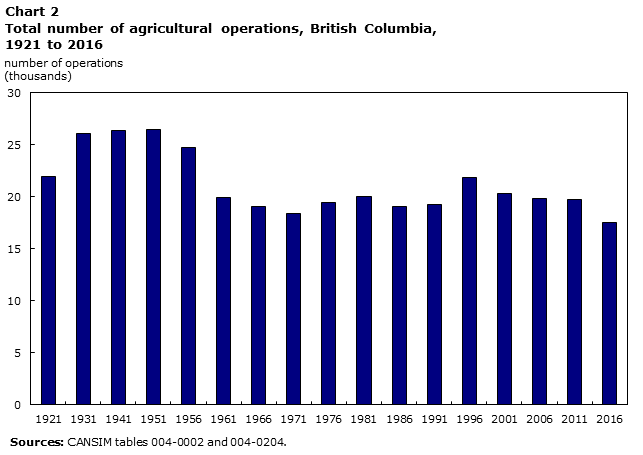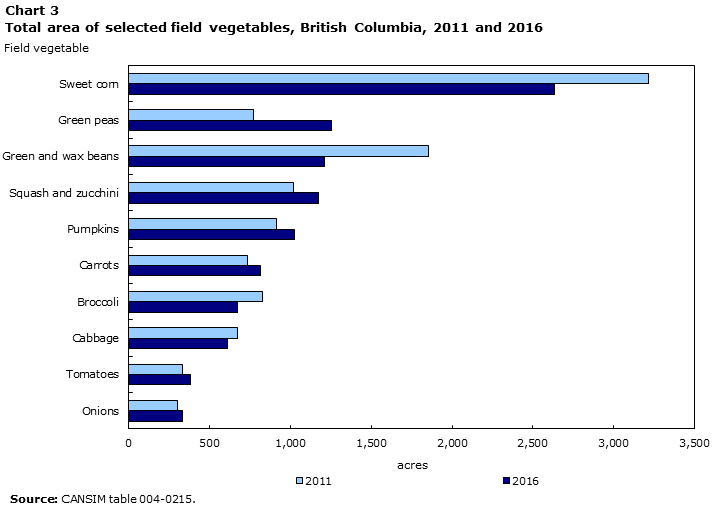Farm and Farm Operator Data
Small farms and direct marketing play a large role in British Columbia
Archived Content
Information identified as archived is provided for reference, research or recordkeeping purposes. It is not subject to the Government of Canada Web Standards and has not been altered or updated since it was archived. Please "contact us" to request a format other than those available.
Over 4 in 10 farms in British Columbia counted by the 2016 Census of Agriculture were small (less than $10,000 in receipts), more than double the national average for this size of farm. Over two-fifths of these operations reported selling food products directly to consumers.
Unique characteristics of small farms had an impact on the overall nature of the agricultural sector in British Columbia. Due to the prevalence of small farms, British Columbia reported the highest rate of off-farm work and the second highest rate of direct marketing.
Although small farms were more prevalent in British Columbia than in other parts of the country, the province also had large operations engaged in the production of fruits, berries and nuts, greenhouse production, livestock, poultry and field crops.
British Columbia had the second largest area under glass with the majority of the area reported by large operations.
Primary agriculture represented 0.6% of provincial gross domestic product (agricultural GDP) in 2013. This percentage increased to 3.4% when agricultural input and service providers, primary producers, food and beverage processors, and food retailers and wholesalers industries were taken into account (Statistics Canada. 2013. Special tabulation, based on 2013 gross domestic product by industry – provincial and territorial).
Agricultural operations in British Columbia employed 44,556 people in 2015.

Data table for Chart 1
| Province | Percent |
|---|---|
| Ontario | 59.6 |
| British Columbia | 21.6 |
| Quebec | 10.3 |
| Alberta | 4.7 |
| Other | 3.8 |
|
Note: Totals may not equal 100% due to rounding. Source: CANSIM tables 004-0217. |
|
Fewer farms from five years earlier
The 2016 Census of Agriculture counted 17,528 census farms in British Columbia, down 11.3% from 2011 and almost double (-5.9%) the decline nationally. British Columbia ranked fifth among the provinces in the number of farms, accounting for 9.1% of the national total.

Data table for Chart 2
| Year | Number of operations (thousands) |
|---|---|
| 1921 | 21,973 |
| 1931 | 26,079 |
| 1941 | 26,394 |
| 1951 | 26,406 |
| 1956 | 24,748 |
| 1961 | 19,934 |
| 1966 | 19,085 |
| 1971 | 18,400 |
| 1976 | 19,432 |
| 1981 | 20,012 |
| 1986 | 19,063 |
| 1991 | 19,225 |
| 1996 | 21,835 |
| 2001 | 20,290 |
| 2006 | 19,844 |
| 2011 | 19,759 |
| 2016 | 17,528 |
| Sources: CANSIM tables 004-0002 and 004-0204. | |
However, British Columbia reported the largest absolute increase among the provinces in the number of farms reporting vegetables, up 289 from 2011 to 2,329 farms. Most of the new operations reporting were small.
While Ontario reported the largest absolute number of farms with gross farm receipts of less than $10,000, British Columbia reported the largest proportion of small farms. In 2016, 41.6% of British Columbia’s farms fell into this sales class. Nationally, small farms accounted for 17.7% of all farms.
British Columbia has the highest proportion of female farm operators in Canada
There were 26,430 farm operators in British Columbia in 2016, down 11.7% from 2011.
British Columbia had the highest proportion of female farm operators (37.5%) in Canada in 2016, up from 36.5% in 2011. Nationally, women accounted for 28.7% of all farm operators in 2016.
From 2011 to 2016, the proportion of farm operators aged 55 years and older in British Columbia rose to 58.5%. However, the proportion of young farm operators (under 35 years old) increased to 6.9%. Over the five-year period, the average age of operators edged up from 55.7 to 56.3 years.
| Age group | 2011 | 2016 |
|---|---|---|
| Percent of farm operatorsTable 1 Note 1 | ||
| Under 35 years old | 5.4 | 6.9 |
| 35 to 54 years old | 40.5 | 34.6 |
| 55 years and older | 54.1 | 58.5 |
| Total farm operators | 100.0 | 100.0 |
|
||
Just under one-quarter (24.4%) of farm operators in British Columbia worked more than 40 hours a week on average on farm in 2015, down from 25.7% five years earlier and the lowest level in the country. Nationally, over one-third (37.5%) of farmers worked an average of more than 40 hours a week in 2015.
Conversely, over half of the farm operators (51.1%) in British Columbia reported having an off farm job in 2015, down from the 52.6% in 2010 but still the highest level in Canada. Nationally, 44.4% of farm operators worked off the farm in 2015.
Total farm area and cropland decrease
The total farm area over which farmers had stewardship in British Columbia decreased 0.8% from 2011 to 6.4 million acres in 2016. The drop in total farm area was accompanied by a 3.1% decline in cropland to 1.4 million acres.
While the total farm area fell, average farm size grew from 327 acres in 2011 to 365 acres in 2016. This five-year period saw shifts of area away from hay and certain horticultural production (sod and nursery) to field crops and fruits, berries and nuts.
Start of text box
Total farm area, which is land owned or operated by an agricultural operation, includes:
- cropland;
- summerfallow;
- improved and unimproved pasture;
- woodlands and wetlands;
- all other land (including idle land, and land on which farm buildings are located).
End of text box
| Component of cropland | 2011 | 2016 |
|---|---|---|
| Percent of croplandTable 2 Note 1 | ||
| Field crops | 29.8 | 33.7 |
| Hay | 64.1 | 60.0 |
| Vegetables | 1.1 | 1.1 |
| Fruits, berries and nuts | 4.1 | 4.4 |
| Sod and nursery | 0.9 | 0.8 |
| Total cropland | 100.0 | 100.0 |
|
||
Spring wheat overtakes canola as the leading crop
The field crop area in British Columbia increased 9.6% from 2011 to 483,957 acres in 2016. Nationally, British Columbia ranked sixth in terms of field crop area.
In 2016, spring wheat, canola and oats continued to be the leading field crops by area in British Columbia.
Dry field peas drove the increase in field crop area in British Columbia. As a result of high prices and crop rotation advantages dry field peas area in British Columbia rose 379.2% from 2011 to 49,073 acres.
Crop rotations offer environmental and agronomic benefits including boosting biodiversity and breaking pest cycles while also increasing nutrient utilization. This practice improves capital and labour utilization by staggering planting and harvest windows and helps to manage business risk by varying products and hedges against commodity specific environmental and disease pressures.
| Field crop | 2011 | 2016 |
|---|---|---|
| Acreage | ||
| Spring wheat | 81,971 | 100,929 |
| Canola | 88,557 | 95,172 |
| Oats | 86,892 | 67,515 |
| Source: CANSIM table 004-0213. | ||
British Columbia ranks second for fruits, berries and nuts
The total area of land dedicated to fruits, berries and nuts production in British Columbia rose 3.6% from 2011 to 62,679 acres. As a result of increased international demand, blueberry area rose 13.1% to 23,585 acres. Blueberries were by far the leading fruits, berries and nuts commodity in area farmed, followed by apples (9,689 acres) and grapes (9,652 acres).
British Columbia ranked first in terms of the number of farms reporting fruits, berries and nuts, accounting for over one-third (36.1%) of all farms reporting fruits, berries and nuts nationally.
From 2011 to 2016, field vegetable area declined 1.7% to 16,008 acres. The leading field vegetables reported in 2016 were sweet corn (2,634 acres), green peas (1,252 acres) and green and wax beans (1,210 acres).

Data table for Chart 3
| Field vegetable | 2011 | 2016 |
|---|---|---|
| acres | ||
| Onions | 305 | 331 |
| Tomatoes | 333 | 383 |
| Cabbage | 672 | 611 |
| Broccoli | 825 | 675 |
| Carrots | 733 | 817 |
| Pumpkins | 914 | 1,028 |
| Squash and zucchini | 1,018 | 1,173 |
| Green and was beans | 1,852 | 1,210 |
| Green peas | 772 | 1,252 |
| Sweet corn | 3,216 | 2,634 |
| Source: CANSIM table 004-0215. | ||
The area dedicated to greenhouse flower and vegetable production rose 3.7% from 2011 to 53.0 million square feet in 2016. Most of this area was dedicated to vegetable (33.1 million square feet) production.
British Columbia the lone province to report more dairy cows
The number of dairy cows in British Columbia increased 2.9% from 2011 to 75,853 head in 2016, the lone increase in the country. British Columbia ranked fourth in terms of the number of dairy cows nationally. Over the same period, the number of farms reporting dairy cows in British Columbia declined by 7.2%.
While the number of dairy cows rose 2.9%, the increase in milk production (+8.7%, CANSIM table 003-0011, accessed April 26, 2017) was more pronounced as a result of increased production per animal. Gains in efficiency are attributable to improvements in animal nutrition, genetics, and production practices.
British Columbia and Alberta were the only provinces to buck the continued decline in beef cattle in 2016. The number of beef cattle in British Columbia increased by 4.0% from 2011 to 310,731 head. However, the number of farms reporting beef cattle declined by 10.7% over the same period.
The gain in beef cattle in British Columbia was driven by an 11.1% increase in breeding stock and a 10.4% rise in calves. These increases were attributable to British Columba’s proximity to the beef processing capacity of Alberta and high beef prices between 2011 and 2016.
In 2016, the number of pigs in British Columbia edged down 0.2% to 88,862 head. Provincially, British Columbia ranked sixth in terms of the number of pigs in Canada.
Gross farm receipts grow faster than operating expenses
Gross farm receipts in British Columbia were $3.7 billion in 2015, while operating expenses were $3.2 billion. On average, for every dollar in receipts, farms incurred 85 cents in expenses in 2015; an expense-to-receipt ratio of 0.85. In 2010, the expense-to-receipt ratio was 0.89.
The expense-to-receipt ratio varied among farm types. In 2015, operations classified as dairy and milk production continued to have the most favourable ratio of 0.79 in spite of a deterioration since 2010 when the ratio was 0.77.
Beef and feedlot type operations reported the greatest improvement in the expense-to-receipt ratio, falling from 1.02 in 2011 to 0.86 in 2016. Conversely, the ratio for hog and pig type operations showed the largest deterioration, rising from 0.93 to 0.97.
Start of text box
The expense-to-receipt ratio is the average amount of operating expenses incurred for a dollar in farm receipts. The ratio is calculated in current dollars.
Price indices were used to obtain constant dollar estimates of receipts, expenditures and capital values in order to eliminate the impact of price changes in year-to-year comparison.
Census Day was May 10, 2016. Farmers were asked to report their receipts and expenses for the last complete fiscal or calendar year (2015).
End of text box
Other agriculture highlights in British Columbia
- In British Columbia, 4.1% of farms reported having renewable energy producing systems in 2015, compared with 5.3% of farms nationally.
- In British Columbia, 89.1% of incorporated farms were family corporations in 2016, up from 87.7% in 2011. Nationally, family corporations accounted for 89.4% of the incorporated farms in 2016.
- The 2016 Census of Agriculture marked the first time farm operators were asked to report whether they had a written succession plan. In 2016, 6.7% of farms in British Columbia had a written succession plan, compared with 8.4% nationally.
- The proportion of farms producing organic products in British Columbia rose from 2.9% in 2011 to 3.1% in 2016. Nationally, farms producing organic products accounted for 2.2% of total farms in 2016.
- In British Columbia, 3.7% of farms reported using automated animal feeding technology in 2015.
- In British Columbia, the value of the land and buildings per acre increased 0.5% (in 2016 constant dollars) from 2011 to $5,321 in 2016. At the national level, this value was $2,696 per acre.
- In British Columbia, 32.3% of farms reported selling agricultural products directly to consumers in 2015.
Canada 150: Farming in British Columbia
British Columbia joined Confederation on July 20, 1871. In 1881, the first census year in which the province of British Columbia was included, the province had a population of 49,459 and 2,743 reported farms. By 1921, there were 43,569 acres of fruits, berries and nuts reported in the province and 2,619 acres of vegetables. There were 62,679 acres of fruits, berries and nuts reported in the province in 2016. There were also 16,008 acres of vegetables, over six times more than in 1921.
Statistics Canada would like to thank the farming community of British Columbia for their participation and assistance in the 2016 Census of Agriculture.
Start of text box
Census farm: An operation is considered a census farm (agricultural operation) if it produces at least one of the following products intended for sale:
- Crops: Hay, field crops, tree fruits or nuts, berries or grapes, vegetables, seed;
- Livestock: Cattle, pigs, sheep, horses, game animals, other livestock;
- Poultry: Hens, chickens, turkeys, chicks, game birds, other poultry;
- Animal products: Milk or cream, eggs, wool, furs, meat;
- Other agricultural products: Christmas trees, sod, greenhouse or nursery products, mushrooms, honey or bees, maple syrup and its products.
The data for Yukon and the Northwest Territories are not included in the national totals because of the different definition of an agricultural operation in the territories and confidentiality constraints. The data for Yukon and the Northwest Territories are presented separately.
Farm type: Farm type is established through a procedure that classifies each census farm according to the predominant type of production. This is done by estimating the potential receipts from the inventories of crops and livestock reported on the questionnaire and determining the product or group of products that make up the majority of the estimated receipts. For example, a census farm with total potential receipts of 60% from hogs, 20% from beef cattle and 20% from wheat, would be classified as a hog and pig farm. The farm types presented in this document are derived based on the 2012 North American Industrial Classification System (NAICS).
P.T.O. hp (Power Take Off horsepower): The measure of the power available from a tractor engine to drive implements.
Gross farm receipts: The Census of Agriculture measures gross farm receipts for the calendar or accounting year prior to the census. Gross farm receipts (before deducting expenses) in this analysis include:
- receipts from all agricultural products sold;
- program payments and custom work receipts.
The following are not included in gross farm receipts:
- sales of forestry products (for example: firewood, pulpwood, logs, fence posts and pilings);
- sales of capital items (for example: quota, land, machinery);
- receipts from the sale of any goods purchased only for retail sales.
Total operating expenses: The Census of Agriculture measures operating expenses for the calendar or accounting year prior to the census. Total operating expenses include:
- any expense associated with producing agricultural products (such as the cost of seed, feed, fuel, fertilizers, etc.).
The following are not included in total operating expenses:
- the purchase of land, buildings or equipment;
- depreciation or capital cost allowance. Depreciation represents economic "wear and tear" expense. Capital cost allowance represents the amount of depreciation written off by the tax filer as allowed by tax regulations.
2010 to 2015: Some data refer to a reference period other than Census Day. For example, for financial data the reference period is the calendar or accounting (fiscal) year prior to the census.
Farm operator: According to the census, a farm operator is any person responsible for the management decisions made for an agricultural operation as of May 10, 2016.
End of text box
Contact information
For more information, or to enquire about the concepts, methods or data quality of this release, contact us (toll-free 1-800-263-1136; 514-283-8300; STATCAN.infostats-infostats.STATCAN@canada.ca) or Media Relations (613-951-4636; STATCAN.mediahotline-ligneinfomedias.STATCAN@canada.ca).
- Date modified:
